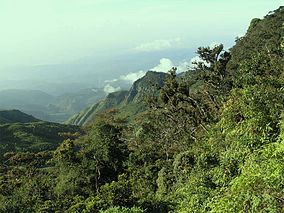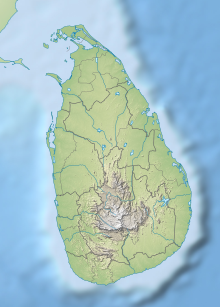Our website is made possible by displaying online advertisements to our visitors.
Please consider supporting us by disabling your ad blocker.
Horton Plains National Park
| Horton Plains National Park | |
|---|---|
| හෝර්ටන් තැන්න ජාතික උද්යානය | |
 World's End, a sheer precipice within the park | |
| Location | Central province, Sri Lanka |
| Nearest city | Ohiya and Nuwara Eliya |
| Coordinates | 6°48′N 80°48′E / 6.800°N 80.800°E |
| Area | 3,160 ha (12.2 sq mi) |
| Established | 1969 (Nature reserve) 1988 (National park) |
| Governing body | Department of Wildlife Conservation |
| World Heritage site | 2010 (within the site Central Highlands of Sri Lanka)[1] |
| UNESCO World Heritage Site | |
|---|---|
| Criteria | Natural: ix, x |
| Reference | 1203 |
| Inscription | 2010 (34th Session) |
| Area | 56,844 ha |
| Buffer zone | 72,645 ha |
Horton Plains National Park (Sinhala: හෝර්ටන් තැන්න ජාතික උද්යානය, romanized: Hortan Thanna Jathika Udyanaya) is a national park in the central highlands of Sri Lanka that was designated in 1988. It is located at an elevation of 2,100–2,300 m (6,900–7,500 ft) and encompasses montane grassland and cloud forest. It is rich in biodiversity and many species found here are endemic to the region.
The Horton Plains are the headwaters of three major Sri Lankan rivers, the Mahaweli, Kelani, and Walawe. In Sinhala the plains are known as Maha Eliya Plains (මහ එළිය තැන්න). Stone tools dating back to Balangoda culture have been found here. The plains' vegetation is grasslands interspersed with montane forest and includes many endemic woody plants. Large herds of Sri Lankan sambar deer feature as typical mammals and the park is also an Important Bird Area with many species not only endemic to Sri Lanka but restricted to the Horton Plains. Forest dieback is one of the major threats to the park and some studies suggest that it is caused by a natural phenomenon.
The sheer precipice of World's End and Baker's Falls are among the tourist attractions of the park.
Previous Page Next Page
Taman Nasional Dataran Horton BAN হর্টন সমভূমি জাতীয় উদ্যান Bengali/Bangla Parc Nacional de les Planes d'Horton Catalan Horton-Plains-Nationalpark German Parque nacional de las Llanuras de Horton Spanish Horton Plainsin kansallispuisto Finnish Parc national de Horton Plains French हॉर्टन प्लैन्स राष्ट्रीय उद्यान HI ഹോർട്ടൻ പ്ലെയിൻസ് ദേശീയോദ്യാനം Malayalam Park Narodowy Płaskowyż Hortona Polish



